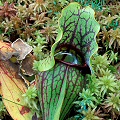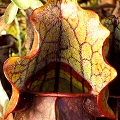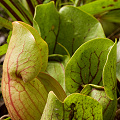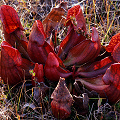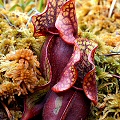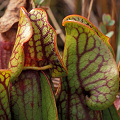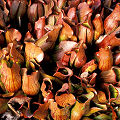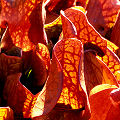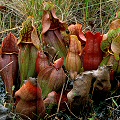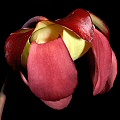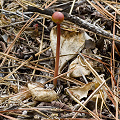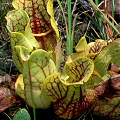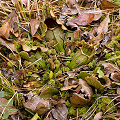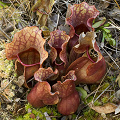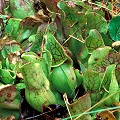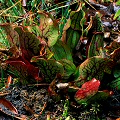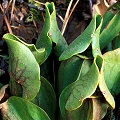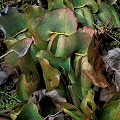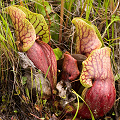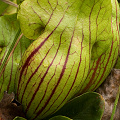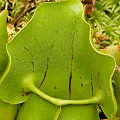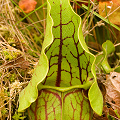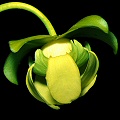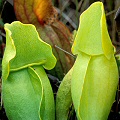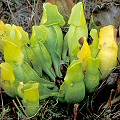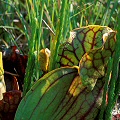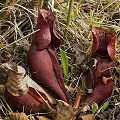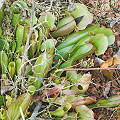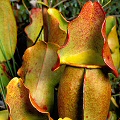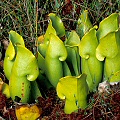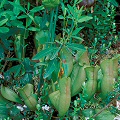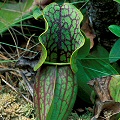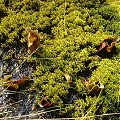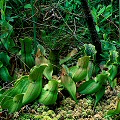Q: About Sarracenia purpurea, the purple pitcher plant
A: Sarracenia purpurea may appear to be a simple, primitive
pitcher plant. But that is just because it is small---do not be deceived, for this is a very complicated and subtle plant.
Furthermore, it is clearly the most successful of all the Sarracenia in that its range is vast
compared to its congeners. Oh yes, this is a very slick little plant.
Sarracenia purpurea pitchers are small, up to 30 cm long. They are squat and have a large lip. The pitcher
lid, unlike in erect pitcher plants, does not shield the pitcher opening. Instead, the lid is erect, with a pair of lateral
ear-like wings on each side of the pitcher lip. Instead of being called a lid, it is usually called the hood. This hood is usually
beautifully veined with treelike patterns, and is covered with stiff hairs pointing towards the pitcher opening.
Sarracenia pitchers usually persist for only a year at most, but the pitchers of
Sarracenia purpurea survive in fine shape for two years unless they are damaged by fire or truly
excessively cold conditions. This might be part of the secret for their success. The pitchers are filled with fluid which
contains enzymes that, for at least a portion of their first year of life, are produced by the
plant. (Despite what you might read elsewhere, S. purpurea produces digestive enzymes;
not everyone keeps up on their reading!)
Digestion in the pitcher is aided, especially during the second year, by the commensal organisms
that live in the pitchers.
Oh, as for commensals, there are many interesting creatures that live in the pitcher fluid. The mosquito
Wyeomyia smithii is the most famous, as its larvae that flick about in the waters
of the pitcher fluid have shown a genetic shift in their life-cycle
in order to accommodate global climate changes. The ravenously carnivorous
larvae of the midge Metriocnemus knabi also live in
the pitchers. These larvae do not molest the larvae of Wyeomyia smithii mosquitos, but they do attack
non-native mosquito larvae! Weird!
The flower of Sarracenia purpurea is purplish to red, although it is green in the anthocyanin-free
form (described below).
The subspecies
Now listen up, FAQ-reader! If you are dozing as you read the FAQ, wake up! I need your attention because we are about to delve
into a complicated area--the various names for plants within the species Sarracenia purpurea.
It is tricky, so PAY ATTENTION! I am telling you, I have lost sleep over these plants.
Over the years, many different names were given to different populations of this plant. However, after much analysis, it was
concluded that the variously named populations were nearly all just the same species of plant. The various plant names were only
denoting how the plants responded to their disparate environmental conditions.
Only two subspecies are generally recognized today:
Sarracenia purpurea subsp. purpurea to the north, and
Sarracenia purpurea subsp. venosa to the south. Ellison has pointed
out that Sarracenia purpurea subsp. purpurea occurs in areas that
were recently glaciated, while Sarracenia purpurea subsp. venosa
is found only in unglaciated areas.
Range (S. purpurea subsp. purpurea)
USA states:
Delaware, Maryland, D.C., New Jersey, Pennsylvania, New York, Connecticut, Rhode Island,
Massachusetts, Vermont, New Hampshire, Maine, Ohio, Indiana, Michigan (upper and lower), Illinois, Wisconsin,
and Minnesota. (Reports for Iowa are probably anecdotal.)
Canada: Alberta, British Columbia, Labrador, Manitoba, New Brunswick, Newfoundland, Northwest Territories,
Nova Scotia, Ontario, Prince Edward Island, Saskatchewan, and Quebec;
in other words, every province except Yukon and Nunavut (data from NatureServe.org, BONAP.org).
France: Saint-Pierre-et-Miquelon (Saint Pierre Island, Miquelon Island).
While this is a huge distribution, within this area it occurs only in isolated patches, so it
is a plant of some rarity.
Range (S. purpurea subsp. venosa)
USA states:
New Jersey, Maryland, Delaware, Virginia (500 plants remaining as of 2007, mostly at one site
(Sheridan, pers. comm. 2007)), North Carolina, South Carolina, and Georgia (Rabun County, 1 site;
Tattnall County, 1 site still extant as of 2007---Sheridan (pers. comm. 2007)). Populations in West Virginia are non-native,
and were
introduced from a now-extirpated population from Highpoint, Maryland (Sheridan, pers. comm. 2007). Similarly,
populations in Washington state and California are also introduced.
In the region of subspecies overlap, intermediate plants are found readily and I have largely given up on trying to separate
specimens from this area. They simply drive me mad, and any armchair naturalist who tells you these plants can easily be
identified should visit plant populations in the confusing overlap zones (New Jersey towards Virginia).
Take a look at the relevant on-line field trip descriptions
I have posted in this FAQ to learn more about those areas. The fact that the two subspecies have overlapping ranges in which
they interbreed does not suggest they should not be maintained as separate subspecies; the overlap area is relatively
small compared to the overall ranges.
Fortunately, the differences between the two subspecies are fairly reliable. I recommend using the following characters.
1)The outer surface of the pitcher of the northern subspecies is smooth, glossy, and waxy, while the outer pitcher surface of
the southern subspecies is rough or pubescent.
2)The hood of the northern plant tends to be smaller, and if pinched together the lateral ears barely touch, while the lateral ears
usually overlap readily in the southern plant.
3)The northern species has pitchers which are overall 3 × longer than the width of the pitcher mouth; the
southern pitchers are not so elongate.
4)The flowers of the northern subspecies are a darker red or purple.
You can often find individual plants that violate one or more of these characters; you must identify plants using several
specimens. Think "population level"! Incidentally, not everyone is quite sure that it is correct to use the
subspecies names at all. Recent research on climate variations across the continent suggest that the two subspecies may actually
just be the result of climate gradients. Is it possible they will find evidence suggesting that
McDaniel (as described below) was right after all, and that the subspecies should be united?
Meanwhile, at least one naturalist has noted in on-line, unpublished
musings that the northern plants should
be divided into a coastal entity and an inland entity of as-yet unspecified rank. Would such musings bear the scrutiny of a
refereed peer review process?
The varieties and forms of Sarracenia purpurea
Now, let us look at things a little more closely. First, in the Blue Ridge and Appalachian Mountains there are some Sarracenia purpurea plants. They are found only in the mountains of North Carolina (about 20 sites in Henderson, Transylvania, Alexander, Macon, Buncombe, and Iredell Counties), Georgia (1 site in Rabun County), and South Carolina (1 site in Greenville County). Other sites may exist, but they have not been disclosed. Some botanists think these are a mix of subsp. purpurea at high elevation, and subsp. venosa at lower elevations. Other botanists think they may be subsp. venosa, and further have seen what they believe are taxonomic features worthy of recognition, hence the name Sarracenia purpurea subsp. venosa var. montana.
Supposedly Sarracenia purpurea subsp. venosa var. montana is different from the nominal subspecies because the edges of the pitcher hood clasp towards each other. Unfortunately, I have seen this plant in several sites and I have only seen this character reliably expressed in plants from the type location for the variety. Other features, not given in the original description but claimed by horticulturists, are that these plants are more intensely or brightly colored than the normal variety, or that the pitcher coloration is restricted to the venation and does not occur as a pitcher blush. These statements may hold for the few clones in cultivation, but not for the populations in the wild. A character in the varietal description is the nature of the hairs on the hood. They are supposedly shorter (0.8-1.0 mm) than the hood hairs of the coastal plants (1.5-3.0 mm). I have not looked too much at this character, but it does seem to hold well. The mountain plants may indeed be a separate variety, but I cannot say I am particularly convinced.
In the northern subspecies, an occasional anthocyanin-free mutant occurs. This mutant has been given
the name Sarracenia purpurea subsp.
purpurea f. heterophylla. It is a very pretty mutant, and has amazingly
electric green leaves and yellow flowers. I have only seen this form in Ontario, but records ranging from ancient to more
current exist for sites in Massachusetts, Michigan (Montmorency County, and also the upper peninsula),
Minnesota, Connecticut, Newfoundland, New York, and Pennsylvania. Unfortunately, the details of locations must be kept secret.
In the southern subspecies, the anthocyanin-free form has been given the name Sarracenia purpurea subsp.
venosa f. pallidiflora. Currently, this is merely a plant of horticultural
interest, since it has never been found in the wild.
If you are waiting for me to talk about Sarracenia purpurea subsp.
venosa var. burkii, I treat this
as a separate species (S. rosea).
In summary, the named entities within the species are:
Sarracenia purpurea L. subsp. purpurea
Sarracenia purpurea subsp. purpurea f. heterophylla (Eaton) Fern.
Sarracenia purpurea subsp. venosa (Raf.) Wherry
Sarracenia purpurea subsp. venosa f. pallidiflora S.McPherson & D.E.Schnell
Sarracenia purpurea subsp. venosa var. montana D.E.Schnell & R.Determann
Unnamed entities
Students of Sarracenia purpurea know that there are yet further types of
Sarracenia purpurea that have interesting features. These have not all been named, but should be
mentioned anyway.
In some places, especially where
S. purpurea subsp.
purpurea f. heterophylla grows, one may be able to find plants that are
referred to as being "veinless". These are plants that may have plenty of red coloration in the pitchers, but the
coloration does not include venation. Some of the plants look like they have been lightly dusted with an airbrush loaded with orange
or red coloration. In extreme cases, these plants look just like the anthocyanin-free form, but a careful check of the
rhizome will reveal red coloration there. "Semi-veinless" plants are much like "veinless" plants
but with small amounts of residual venation. These plants all apparently represent hybrids between the normal and the
anthocyanin-free plants.
In 2002, Schnell noted that there are two color variants within S. purpurea subsp.
venosa var. venosa (i.e. the coastal plants). One variant is green with
red veins. The other variant tends to become all-red, obliterating the veins. You can see photos of those above. However, by
2011 he has apparently concluded that because of intermediate plants, these two extremes do not merit taxonomic recognition.
Finally (whew!) I want to return the conversation to the confusing plants that occur in the geographic overlap zone between
the the two S. purpurea subspecies. The plants in this overlap zone, especially from the area of the New Jersey Pine Barrens, are often referred to by
horticulturists as "intergrades." A straightforward, and nice term---I just wanted to make sure you had heard it
so you do not develop a blank look if you encounter it.
A name goof-up
You may encounter some web sites that refer to the
southern subspecies as "S. purpurea subsp. purpurea"
and the northern subspecies as "S. purpurea subsp. gibbosa"!
What the hell is going on here? Well, I will tell you the skinny, and why these web sites should know better.
By the way, this is kind of a boring bit of history, so I will forgive
you if you skip this, and proceed to the next FAQ entry.
Historically, the north and south subspecies were treated by botanists using the following systems of names:
Linnaeus (1753): Treated both north and south as simply S. purpurea
Rafinesque (1840): S. gibbosa (north), S. venosa (south)
Wherry (1933): S. purpurea subsp. gibbosa (north), S. purpurea subsp. venosa (south)
There things stood until around 1970. But to proceed in our history, I have to explain a bit of botanical law regarding
names. When botanists name plants, one of the things they must do is collect a specimen and preserve it in a plant museum called
an herbarium. That preserved plant sample is called the "type specimen."
When you are dividing some previously established plant species into subcategories such as varieties or
subspecies, it is botanical tradition that one of the
new categories will be an autonym, that is, a repeat of the species name
(like S. minor var. minor). But do you see that in Wherry's 1933
treatment, he did not follow this rule? He did not name one of his two entities
"S. purpurea subsp. purpurea." Whoops!
In 1972 he changed his tune slightly, and published a paper establishing names
as we now know them:
Wherry (1972): S. purpurea subsp. purpurea (north), S. purpurea subsp. venosa (south)
This is the usage as we currently know it. Over the following decades countless scientists used these names and published many
scientific studies using them. But unfortunately, what Wherry did not know was that a year before he published
his 1972 paper, McDaniel published a monograph of the genus (and a nice one, I should say). McDaniel was something of a lumper,
and in his monograph he
concluded there was no evidence to divide S. purpurea into any kind of subspecies at all.
(He concluded the same for the various plants in the S. rubra complex.)
McDaniel also pointed out that no
botanist had ever gotten around to designating a "type specimen" for the species, so he kindly selected a
substitute that came from the Carolinas, i.e. the southern subspecies (as we would now call it). So McDaniel's treatment
is:
McDaniel (1971): Both as S. purpurea, type specimen from the Carolinas.
So, what this means (as discovered by a scientist named Reveal) is that since the type of the species (as set by McDaniel)
is from the southern part
of the range, if you want to use two subspecies then you have to use a weirdly reversed set of names:
Reveal (1993): S. purpurea subsp. gibbosa (north),
S. purpurea subsp. purpurea (south)
Ychh! What a mess! All those papers published between 1972 and 1993 would have to be corrected in a funky, reversed way!
Fortunately, Martin Cheek (and it is from his 1994
paper I am constructing this thumbnail history) submitted a proposal to the Committee for Spermatophyta to fix this.
The Committee agreed with Cheek's logic, and in 1999 voted to retain the usage as we all know it.
Page citations: Bradshaw, W.E. & Holzapfel, C.M. 2001;
Cheek, M. 1994, 2001; Ellison, A.M. et al. 2004; Ellison, A.M. & Gotelli, N.J. 2002;
Evans, D. 2006, pers. comm.;
Gallie, D.R., & Chang, S-C. 1997; Kartesz, J. et al. 2009 (BONAP);
Mazur, C.J. & Lechtman, J. 2005;
McDaniel, S. 1971; Naczi, et al. 1999; McPherson, S. & Schnell, D. 2011;
Patrick, T.S et al. 1995;
Petersen, et al. 2000;
Rice, B.A. 2006a; Schnell, D.E. 1976, 2002a; USDA, NRCS 2007; personal observations.
